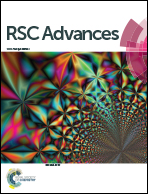Polymer-assisted synthesis and applications of hydroxyapatite (HAp) anchored nitrogen-doped 3D graphene foam-based nanostructured ceramic framework
Abstract
In the present work, a hydroxyapatite anchored nitrogen-doped three-dimensional graphene (HAp-N3DG) skeletal network (foam) based nanostructured ceramic framework (CF) was developed through a polymer-assisted solvothermal route. Field emission scanning electron microscopy (FESEM) and transmission electron microscopy (TEM) studies reveal that the nano sized 0D HAp particles are anchored on the N3DG skeletal network with an average size of less than 50 nm. EDX and X-ray photoelectron spectroscopy (XPS) analysis confirmed the presence of Ca, P, O, N, and C. In addition, XPS analysis reveals the existence of N–C bonds in the prepared sample. The X-ray diffraction (XRD) patterns indicate the presence of hexagonal phase hydroxyapatite and the calculated average crystallite size was found to be 12 nm. The developed HAp-N3DG foam based nanostructured CF was found to have a mesoporous structure and the measured specific surface area (SSA) and the mean pore diameter were found to be 64.73 m2 g−1 and 23.6 nm, respectively. Electrochemical analysis shows that HAp anchored on nitrogen-doped 3D graphene foam based nanostructured CF has moderate electrochemical activity towards lithium ion charge/discharge. In addition, the prepared material showed adsorption activity values of 204.89 mg g−1 and 243.89 mg g−1 for the volatile organic compounds (VOCs) benzene and toluene, respectively. The present findings suggest that the newly developed HAp anchored nitrogen-doped 3DG (HAp-N3DG) skeletal network (foam) based nanostructured CF material can be used in energy devices and in the removal of volatile organic compounds. Moreover, the present study initiates a new kind of approach in energy device (lithium ion battery-LIB) research and in the removal of VOCs.



 Please wait while we load your content...
Please wait while we load your content...